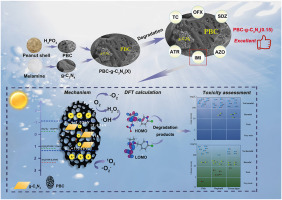, 2025,
abstract
in recent decades, aquatic environmental pollution resulting from the extensive use of pesticides and antibiotics in the agriculture and livestock industries has become a major concern. in this study, a h3po4 -activated biochar-g-c3n4 composite photocatalyst (pbc-g-c3n4 (0.15)) was synthesized for the degradation of pesticides (imidacloprid (imi), atrazine (atr), azoxystrobin (azo)) and antibiotics (tetracycline (tc), ofloxacin (ofx), sulfadiazine (sdz)) under visible light. pbc-g-c3n4 (0.15) achieved 89.7% degradation efficiency for imi within 120 min, 1.8 times higher than g-c3n4, mainly due to 4.4 times increase in photocurrent density. active species identified mainly included 1o2, ·o2−, and ∙oh. density functional theory and uhplc–q exactive ms analysis suggested three degradation pathways for imi, with most intermediates predicted to be less toxic than the parent compound. additionally, pbc-g-c3n4 (0.15) was largely unaffected by environmental factors and achieved over 94% degradation efficiencies for azo, tc, and ofx within 60 min, and over 34% for atr and sdz in 120 min. the degradation efficiencies for imi and tc remained 61.0% and 76.1% after eight cycles, respectively. in natural water, the degradation efficiencies for imi and tc exceeded 30% and 65%, respectively. this research offers valuable insights into the modification of g-c3n4 and the treatment of pesticides and antibiotics in wastewater.
graphical abstract

,if=8